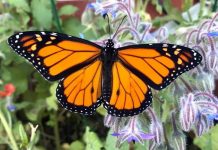The most complete bird found in amber so far, the baby bird is around 99 million years old.
We can’t time travel to the Cretaceous Period, we don’t have photos, we don’t even have paintings or cave drawings – but thanks to the persevering preservative qualities of amber, we are nonetheless offered exquisite glimpses of some of the organisms that called planet Earth their home millions of years ago.
There have been bits and pieces of feathered things found in amber before, but now half of a hatchling has been found and described in a new paper. With most of the skull and neck of the bird, along with part of a wing, hindlimb, and tail all beautifully preserved, it is the most complete bird found in amber so far.
The fossilized specimen was purchased in Myanmar in 2014 by Guang Chen, director of the Hupoge Amber Museum in Tengchong City, China, after he had heard about an amber sample with a strange “lizard claw” inclusion. Chen brought the sample to research team co-leader Lida Xingof the China University of Geosciences, who identified the claw as an enantiornithine foot. Additional imaging of the specimen revealed the remarkable extent of preservation obscured behind thick layers of amber, carbonized plant remains, and clay-filled bubbles.
“It’s the most complete and detailed view we’ve ever had,” says Ryan McKellar of the Royal Saskatchewan Museum, Regina, in Canada, one of the researchers who described the find. “Seeing something this complete is amazing. It’s just stunning.”
The team, who nicknamed the babe Belone, after the Burmese name for an amber colored skylark, were exceedingly surprised by what they were seeing. “[I thought we had] just a pair of feet and some feathers before it underwent CT imaging. It was a big, big, big surprise after that,” says Lida Xing of the China University of Geosciences.
“The surprise continued when we started examining the distribution of feathers and and realized that there were translucent sheets of skin that connected many of the body regions appearing in the CT scan data,” adds McKellar.
Based on the preserved parts, the team identified the hatchling as a member of the extinct avian clade Enantiornithes, of which an artist reconstruction is shown below.
New Scientist notes that the “unfortunate youngster” (because there’s nothing like falling into a puddle of sticky pine sap that you can’t get out of, ever; then again, talk about legacy!) belonged to a group of birds known as “opposite birds” – creatures that lived along with the ancestors of modern birds. Even though opposite birds had cool things like claws on their wings, and jaws and teeth rather in place beaks, they nonetheless bit the dust with the dinosaurs some 66 million years ago.
From looking at its molting pattern, researchers determined that the little guy (or gal) was only in its first days or weeks of life before succumbing to the resin. Its feathers appear as an array of subtle tones ranging from white and brown to dark grey.































